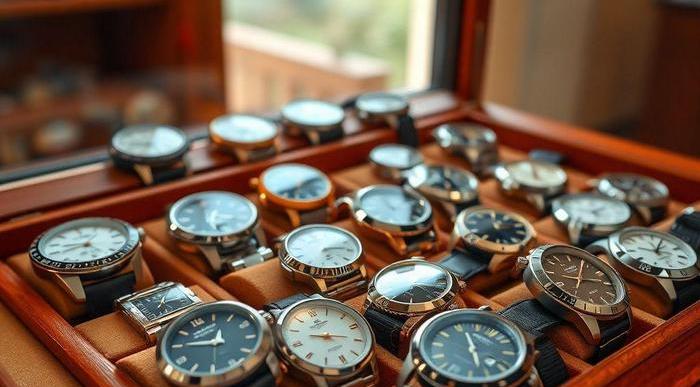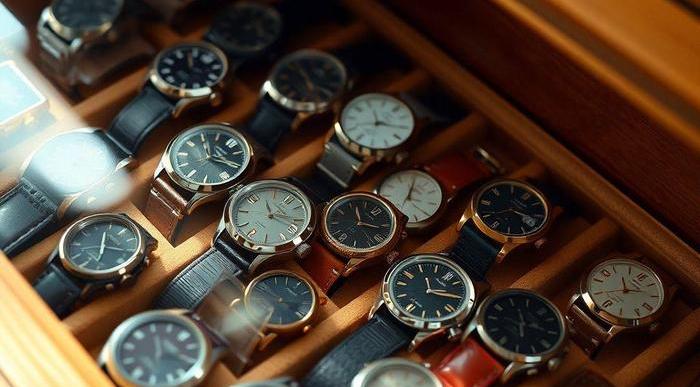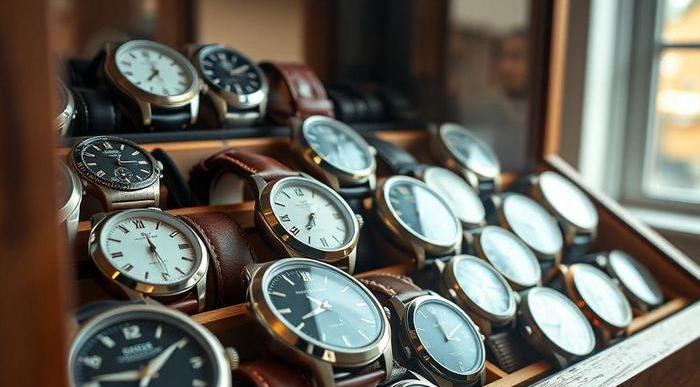How To Spot A Fake: Tips For Authenticating Watches
Note: This page contains affiliate links.
As an Amazon Associate, I earn from qualifying purchases when you click on the link, but you are not charged extra.
In an era where luxury goods are increasingly coveted yet frequently counterfeited, discerning the genuine from the fake is essential, especially in the realm of high-end watches. Whether you’re an avid collector or a first-time buyer, understanding how to authenticate a watch can save you from financial loss and disappointment. This guide offers a comprehensive approach to spotting counterfeit watches, focusing on various aspects of authenticity, from craftsmanship to documentation.
Common Signs Of Counterfeit Watches
Identifying a fake watch often starts with keen observation. While counterfeits can be sophisticated, there are several hallmark signs that can help you distinguish a genuine piece from a replica.
-
Weight and Material Quality: Authentic luxury watches are often made from high-quality materials like stainless steel, gold, or titanium, giving them a substantial weight. If a watch feels surprisingly light or flimsy, it could be a sign of a counterfeit.
-
Logo and Branding: Inspect the logo carefully. Genuine watches will have precise logos that are crisp and clear, while fakes often have logos that are poorly printed, uneven, or misaligned.
-
Movement of the Second Hand: On quartz watches, the second hand ticks in full seconds, while automatic watches often have a sweeping second hand that moves smoothly. If you notice a jerky motion in the second hand, it’s likely a sign of a cheap movement.
-
Crystal Quality: Authentic luxury watches utilize high-quality crystals, often sapphire, which should be scratch-resistant. If the crystal scratches easily, it’s a strong indicator of a counterfeit.
-
Case Back: Many high-end watches have a case back that provides specific details about the model and manufacturer. Examine this area closely; a lack of details or poorly executed engravings can signal a fake.
Understanding Serial Numbers And Authenticity
Serial numbers play a pivotal role in verifying the authenticity of a watch. These unique identifiers, usually located on the case back or between the lugs, help track the watch’s production and history.
-
Check the Manufacturer’s Database: Many luxury brands maintain databases that allow you to verify the serial number. Contacting the manufacturer directly or visiting their website can provide confirmation of authenticity.
-
Look for Consistency: Different models have specific serial number formats, including length and character combinations. Research the model you’re interested in to understand what the correct serial number should look like.
-
Examine Production Dates: Matching the serial number to the production date can reveal whether the watch was manufactured during a certain period, helping to determine if it aligns with the model specifications.
-
Compare with Known Authentic Models: Cross-reference the serial number with known genuine pieces. If discrepancies arise, this could indicate a counterfeit.
How To Examine Watch Craftsmanship

The craftsmanship of a watch reflects its authenticity. Luxury watches are meticulously crafted, with attention to detail in every aspect. Here’s how to examine craftsmanship:
-
Inspect the Finish: Look at the finish of the case and bracelet. Authentic watches will feature a smooth, polished finish with no rough edges or signs of poor quality. The transition between brushed and polished areas should be seamless.
-
Weight Distribution: Hold the watch and assess its balance. Genuine luxury watches typically have a well-distributed weight, indicating quality materials and construction.
-
Details of the Dial: Pay close attention to the dial’s markings, including the logo, indices, and any sub-dials. Authentic watches will have sharp, precise print, while fakes often exhibit inconsistencies or errors in detail.
-
Crown and Pushers: Examine the crown and pushers for quality. They should operate smoothly and feel solid to the touch. Fake watches often have plastic components that feel flimsy.
The Role Of Documentation In Authentication
Documentation plays a crucial role in confirming the authenticity of a watch. This includes the original box, warranty card, and any additional papers that came with the watch.
-
Original Packaging: Authentic luxury watches are often sold with high-quality packaging. Examine the box for quality and authenticity; poor construction or obvious wear may indicate a counterfeit.
-
Warranty and Certification Cards: These cards should contain details such as the model number, serial number, and purchase date. Any discrepancies or signs of tampering can raise red flags.
-
Service History: If the watch has been serviced, documentation should be available. An authentic watch will have service records that correspond with the model and its care.
-
Provenance: If possible, obtain the history of the watch, including previous owners and transactions. A watch with a verified provenance is far less likely to be a counterfeit.
Tools And Resources For Watch Verification

In your quest for authenticity, a variety of tools and resources can assist you in verifying a watch’s legitimacy:
-
Online Forums and Communities: Engage with watch enthusiasts through online forums like Watchuseek or TimeZone. Members often share their experiences and insights on specific brands and models, offering valuable advice on spotting fakes.
-
Authentication Services: Professional authentication services specialize in verifying luxury watches. These companies can provide an expert opinion and certification of authenticity.
-
Mobile Apps: Some apps can help you track the authenticity of watches through serial number databases and community feedback, streamlining the verification process.
-
Reference Books and Guides: Investing in reference books that detail specific brands and models can be beneficial. These books often include photos and specifications that can help in identifying genuine pieces.
The Importance Of Buying From Reputable Dealers
Purchasing from reputable dealers is perhaps the most effective way to ensure the authenticity of a watch. Here’s why it matters:
-
Established Reputation: Reputable dealers often have a long-standing history and positive reviews from customers, making them a reliable source for luxury watches.
-
Certification: Many trusted dealers provide certificates of authenticity with their watches, offering peace of mind for the buyer.
-
Transparency: Reputable dealers are typically transparent about the watch’s history, including any repairs or services performed, which adds to the trustworthiness of the purchase.
-
Return Policies: Established dealers usually have favorable return policies, allowing you to return the watch if it does not meet your expectations.
How To Research Watch Models For Authenticity

Conducting thorough research on a watch model before purchasing can significantly aid in identifying authentic pieces.
-
Official Brand Websites: Start with the official websites of luxury watch brands. They often provide detailed information about specific models, including features and historical context.
-
Watch Forums and Blogs: Participate in watch enthusiast forums and read reputable blogs. These platforms often discuss models in detail, highlighting common counterfeit traits and authentic characteristics.
-
YouTube Reviews: Video reviews can be incredibly helpful, as they often include detailed examinations of both genuine and counterfeit watches, showcasing how to spot differences effectively.
-
Social Media Groups: Engaging in social media groups dedicated to watch collecting can provide real-time insights and experiences from other collectors regarding specific models.
Examining Movement And Mechanisms
The movement of a watch—the mechanism that powers its functions—is a critical element in determining authenticity.
-
Visual Inspection: For watches with transparent case backs, observe the movement closely. Authentic luxury watches will have finely crafted movements with intricate details, often decorated with engravings and high-quality finishes.
-
Sound and Functionality: Pay attention to the sound of the watch. Genuine automatic movements should operate smoothly and quietly, while cheaper movements may produce noticeable ticking sounds.
-
Service Markings: Many high-end watches will have service markings or engravings on the movement itself. Researching these markings can help verify authenticity.
-
Timing Accuracy: Genuine watches typically have a high level of accuracy. Conducting a timing test can reveal discrepancies that might suggest the watch is a counterfeit.
Red Flags To Watch Out For When Purchasing
When purchasing a watch, be vigilant for specific red flags that may indicate a counterfeit.
-
Unbelievably Low Prices: If a deal seems too good to be true, it probably is. Counterfeit watches often flood the market at significantly lower prices than genuine pieces.
-
Lack of Documentation: If the seller cannot provide original documentation, it raises questions about the watch’s authenticity.
-
Poor Quality Photos: Be wary of sellers who provide low-quality images or refuse to send additional photos upon request. Authentic sellers will have high-quality images showing various angles of the watch.
-
Pressure to Buy Quickly: Sellers who pressure you to make a quick decision often have something to hide. Take your time to evaluate the watch and do your research.
Conclusion
Authenticating a watch requires a keen eye, thorough research, and a commitment to understanding the intricacies of watchmaking. By knowing what to look for, from the craftsmanship and movement to documentation and dealer reputations, you can navigate the complexities of the luxury watch market with confidence. Whether you are investing in a timepiece for yourself or a gift for someone special, ensuring authenticity not only protects your investment but also enhances the joy of owning a piece of horological art. Always remember, when in doubt, consult with experts or reputable dealers to safeguard your purchase.
